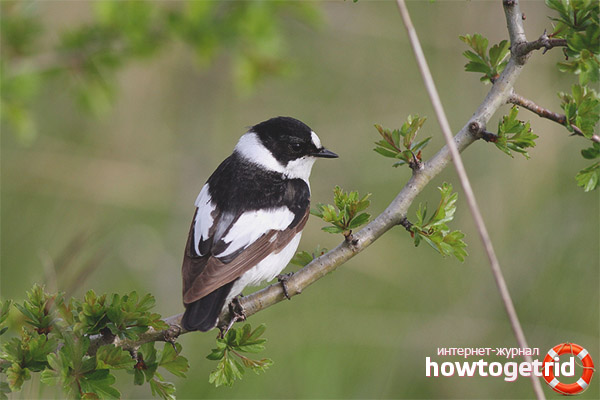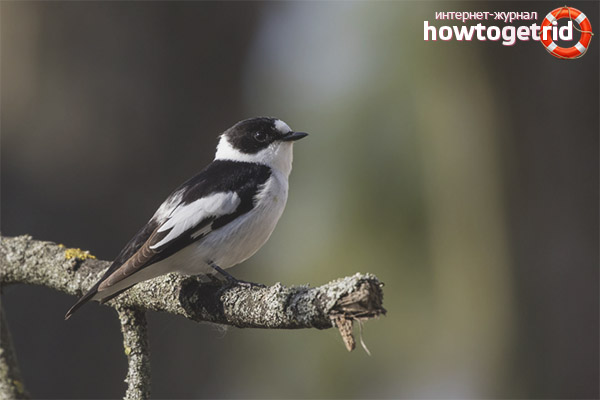The content of the article
By a white-neck we mean a songbird of a migratory character. It belongs to the order Passeriformes and the family of flycatchers. As the name implies, the presented species of the feathered tribe has a distinctive feature. Birds prey on winged insects that buzz and poison human life.
Description
- Representatives of the male half who have reached puberty look quite contrasted. Their plumage is pigmented in black with white markings. The female stands out against the background of the male, because her color is not so contrasting.
- If we compare the breed group under discussion with pies, which are also flytraps, then our representatives of the family have a whitish speck on the frontal part. On the lumbar region there are light marks, the tail is pure black, white fields develop on the wings.
- Females who have crossed the maturity threshold are distinguished by a grayish shade of plumage with brown marks. The lower part is pure white, there is no coating of ocher or brown pigment in the chest area.
- Young animals dressed up in autumn plumage look rather gloomy and are somewhat similar to females. In young individuals, the brisket has an ocher and brownish hue.
- The main distinguishing characteristic of these birds is that on the wings there is a strip painted in white. It is formed due to hiding, as well as fly feathers.
- As for the singing of these birds, their melodies are leisurely, short, consisting of a whistle and a certain fraction of trill. The pestlets are, on the contrary, talkative and fast-singing. When the white-necked women are worried, they switch to a desperate whistle. Individuals of this variety hum melancholy melodies, but they do not necessarily feel sad.
Lifestyle
- Distribution affects European countries, as well as the Urals region. Birds are laid to the Italian coast, are found in Africa, on the Balkan Peninsula. Prefer taiga, mixed, steppe zones.
- In the process of dwelling combined with pestle, common in all parts of Europe. In the vastness of our homeland, the population cannot be called huge, the changing climate is not always suitable for the birds.
- The family under discussion loves forests with broad-leaved trees, and feels great among linden and oak groves. It lives a little less in mixed forests. Birds prefer to settle in park areas, gardens, squares.
Food
- If you pay attention to the name of the individuals represented, then it is easy to guess what is included in the basis of the diet of such birds. It is worth noting that flycatchers are gambling and excellent hunters for various insects.
- Represented birds often enjoy flies, dragonflies and butterflies. It is interesting to observe how such birds hunt. The individual lurks in dense foliage on the trees and at the most opportune moment it suddenly pops up.
- As a result, an individual grabs an insect with a tenacious beak that flew past. After that, the bird immediately returns to the ambush. Often, birds hide under the foliage of trees during the rain. At such moments, the flycatchers try to find themselves various bugs that live on the bark and branches. They also eat spiders and ants.
Breeding
- After wintering, males return to their usual nesting places first. Often individuals fly in April. In most cases, the birds settle in the hollows on the trees. The distance between the dwellings can be up to 50 m. After 1 week, females arrive. Thus begins the mating season in birds.
- As soon as the males notice the females, they begin to show off in front of them in every possible way. In addition, males begin to show their chosen ones their homes. Males widely open wings and tail. You can see how they dance in front of the females. Males sing beautifully and constantly fly into the nest or fly out of it.
- There are frequent cases when more successful males immediately manage to occupy 2 nests. As a result, they invite females there, and in a sense they get grief. In this case, the distance between the dwellings will not exceed 20 m. During nesting, males must have time to feed the families.
- In this case, the nest is located 8 m above the ground. However, indicators may vary depending on the forest and some environmental factors. Inside, individuals line the bottom with dry grass, wool and roots. At this time, the female can lay up to 6 eggs of a bluish color. The second clutch is extremely rare.
The considered individuals have a unique appearance. They do not belong to monogamous birds, therefore, in the nesting season, they can immediately have two families. Males perfectly cope with their duties by feeding females and offspring.
Video: White-necked Flycatcher (Ficedula albicollis)











Submit